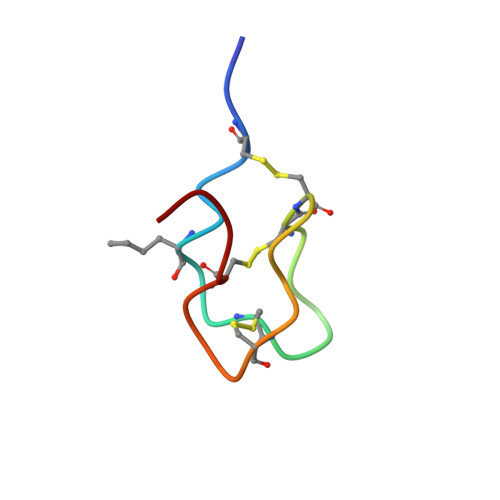Pharmacological characterization of potent and selective NaV1.7 inhibitors engineered from Chilobrachys jingzhao tarantula venom peptide JzTx-V.
Moyer, B.D., Murray, J.K., Ligutti, J., Andrews, K., Favreau, P., Jordan, J.B., Lee, J.H., Liu, D., Long, J., Sham, K., Shi, L., Stocklin, R., Wu, B., Yin, R., Yu, V., Zou, A., Biswas, K., Miranda, L.P.(2018) PLoS One 13: e0196791-e0196791
- PubMed: 29723257
- DOI: https://doi.org/10.1371/journal.pone.0196791
- Primary Citation of Related Structures:
6CGW, 6CHC - PubMed Abstract:
Identification of voltage-gated sodium channel NaV1.7 inhibitors for chronic pain therapeutic development is an area of vigorous pursuit. In an effort to identify more potent leads compared to our previously reported GpTx-1 peptide series, electrophysiology screening of fractionated tarantula venom discovered the NaV1.7 inhibitory peptide JzTx-V from the Chinese earth tiger tarantula Chilobrachys jingzhao. The parent peptide displayed nominal selectivity over the skeletal muscle NaV1.4 channel. Attribute-based positional scan analoging identified a key Ile28Glu mutation that improved NaV1.4 selectivity over 100-fold, and further optimization yielded the potent and selective peptide leads AM-8145 and AM-0422. NMR analyses revealed that the Ile28Glu substitution changed peptide conformation, pointing to a structural rationale for the selectivity gains. AM-8145 and AM-0422 as well as GpTx-1 and HwTx-IV competed for ProTx-II binding in HEK293 cells expressing human NaV1.7, suggesting that these NaV1.7 inhibitory peptides interact with a similar binding site. AM-8145 potently blocked native tetrodotoxin-sensitive (TTX-S) channels in mouse dorsal root ganglia (DRG) neurons, exhibited 30- to 120-fold selectivity over other human TTX-S channels and exhibited over 1,000-fold selectivity over other human tetrodotoxin-resistant (TTX-R) channels. Leveraging NaV1.7-NaV1.5 chimeras containing various voltage-sensor and pore regions, AM-8145 mapped to the second voltage-sensor domain of NaV1.7. AM-0422, but not the inactive peptide analog AM-8374, dose-dependently blocked capsaicin-induced DRG neuron action potential firing using a multi-electrode array readout and mechanically-induced C-fiber spiking in a saphenous skin-nerve preparation. Collectively, AM-8145 and AM-0422 represent potent, new engineered NaV1.7 inhibitory peptides derived from the JzTx-V scaffold with improved NaV selectivity and biological activity in blocking action potential firing in both DRG neurons and C-fibers.
Organizational Affiliation:
Neuroscience, Amgen Discovery Research, Thousand Oaks, California, United States of America.















